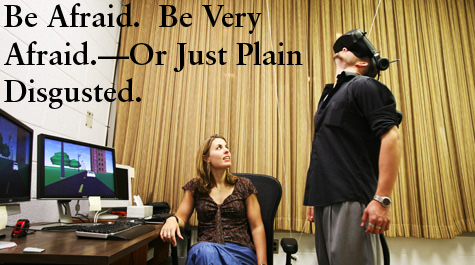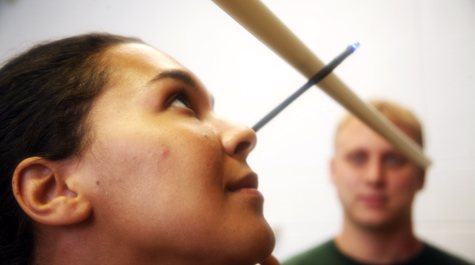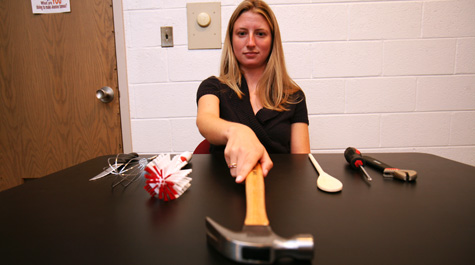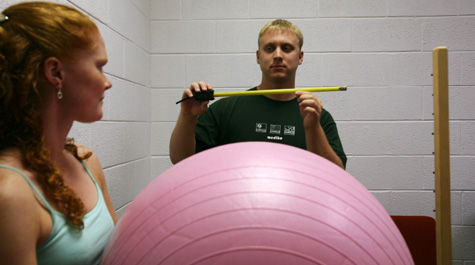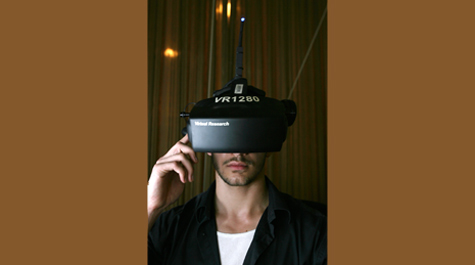Fear is only too real. It also changes things.
The only thing we have to fear, we’re told, is fear itself. But what does fear itself really influence? According to researchers, fear and other negative emotions change just about everything when it comes to how we perceive the world.
“There’s this great German proverb that I found and it’s ‘fear makes the wolf bigger than he is,’” said Jeanine Stefanucci, an assistant professor of psychology. “I think we would just say that we’ve shown that’s true. It not only makes him bigger than he is, but it makes him closer to you, makes him move faster, makes him louder. When you’re afraid, the world is different to you than when you’re not.”
Stefanucci started the Perception Lab at the College of William and Mary when she first came to the school about two years ago. The lab focuses on spatial perception—how far away, how big, or how high things appear—and what factors influence those perceptions.
“Traditionally, people have thought, well, the eye just kind of collects the light rays coming into it and computes the geometry of the world, and that’s how we decided how far things are from us, how high things are, which is true,” Stefanucci said. “It definitely does that, but it does that also with, we believe, input from other parts of the brain and body.”
For instance, Stefanucci said, distances look further to tired people and hills looks steeper to older people. Along those lines, Stefanucci’s lab has been looking at how emotions—in particular, negative emotions such as fear—can affect how people see the world.
Roots of the Perception Lab
The experiments began with two students going to the Sadler Center and asking people about the height of the balcony. The participants who stood on the ground and looked up at the balcony estimated its height somewhat accurately. However, the people who stood at the top of the balcony—and, thus, were more likely to be experiencing fear—overestimated the distance to the ground.
Building on those findings, the members of the Perception Lab teamed up last year with Kim Whitley, a professor from the kinesiology department. Whitley planned to have students rappel off the College’s parking deck for his Adventure Games course.
“Before they would come up on the platform and jump, we would ask them, ‘How high does that look to you?’” said Stefanucci. “An experimenter standing right next to them just starts moving along the parking deck—on a horizontal plane—and they make the experimenter stop at the same distance from them that they believe they are from the target on the ground.”
Using data collected from about 45 people, the researchers found—like in the Sadler Center experiment—that the students who had to jump from the parking deck platform overestimated the distance to the ground. The non-jumpers were more accurate in their assessment.
“We showed that people who are afraid estimate heights to be higher than people who aren’t,” said Stefanucci. “That can be a trait-level thing, so you can have just a general fear of heights in any situation—or we can manipulate it so that in a particular situation you are afraid, which is a state-level evaluation of emotional reaction to the height. "Additionally, during the kinesiology class study, the researchers found that the participants were accurate in predicting their level of happiness during various activities, but “massively over-predicted” their level of fear, said Erika Siegel, a second-year graduate student.
For instance, participants who said that on a scale of one to seven they expected to be a six on happiness came back a week later and reported that they had been about a 5.6 on the happiness scale. But participants who guessed they would be a six on the fear scale came back and reported that they actually only experienced a 3.2 level of fear.
“So, people are bad at forecasting negative emotions like fear and pretty good at forecasting positive emotions like excitement,” said Stefanucci.
Though the lab has mostly done its research by taking participants to real-world locations, they are now taking their studies to virtual worlds.
“We put people in a head-mounted display that displays a virtual world that we’ve created and we can show them maybe 50 heights at once, whereas in the real world, that’s really hard to do,” said Stefanucci. “You have to walk people from building to building and you can fatigue them on the way, which can compound the effect.”
Smell and sound
In addition to branching out into the virtual world, the Perception Lab’s members have also been expanding their research to include other areas of perception.
Siegel has taken the findings from the current research and is looking into whether fear can also affect a person’s perception of smells and sounds.
Last year, she had participants in her auditory study write about a very frightening experience. In the middle of writing about that experience, the participants were stopped and asked to listen to a series of tones, rating them for loudness and length. A control group rated the sounds without writing about frightening experiences.
“We found a pretty reliable difference,” she said. “The fearful participants were hearing tones louder and longer.”
This year, Siegel is is trying to do something similar with smell. Though she has not started yet, she plans on again having participants evoke frightening memories, and while they are in the midst of remembering them, she will waft an odor into their noses and have them rate the intensity and pleasantness of the smell.
“It certainly seems like that would extend to smell as well,” she said. “So, something might smell very powerfully negative if you’re already very afraid, especially if it’s a novel odor or if it’s something that can harm you.”
How we see others
While Siegel investigates smell and sound, two other members of the Perception Lab are looking into how emotions and body state can affect how we might see others. Noah Schwartz, a research fellow with the School of Education, is focusing on how emotion can influence people’s ability to encode and recall faces.
“When you look at facial recognition literature, it’s what parts of the face are you using to identify the face. But I’m looking at what parts you are more likely to forget,” he said. “When we put this into an emotional context, specifically a negative emotional context—something like a crime scene—we can then start to speak to issues in eyewitness testimony.”
For instance, he said, “if I witness a crime and I see that you are the perpetrator, using this method I have developed, I can tell you what parts of the face you’re going to forget. Then when I look at the people in a line-up and see four people who look like you, am I going to pick the person who has everything the same except different eyes, everything the same except a different nose, everything the same except a different mouth? That’s kind of the direction that it’s moving in.”
Schwartz plans on possibly using crime scene photos or another method to evoke negative emotions in his participants. Then, using an eye tracker, he will study how participants look at faces while experiencing negative emotions.
How we see ourselves
Mike Geuss, a recent graduate and current graduate student, is taking what he’s learned in the lab and applying it to how people perceive their own body size. The research, he said, began as an interest in body size as it relates to driving. For instance, people in SUVs tend to see parking spaces as smaller than those who are driving compact cars.
“It’s an evolved mechanism that you see things as smaller because you want things as larger as a safety precaution,” said Geuss. For instance, he said, you wouldn’t want to just squeeze through a doorway if you are being chased by a dog and therefore underestimate the door’s width in order to have some room to spare.
“You can also perceive it as smaller because you perceive yourself as larger than you are,” he said.
Based on that idea, Geuss ran experiments where participants wore a book bag on their front with a curtain rod attached to it. Geuss then asked the participants to estimate how wide they thought an aperture was by adjusting a tape measure that he slowly pulled open for them. Though other researchers have studied body size in reference to apertures, they have always asked participants to either walk through them or if they thought they could walk through. Geuss’s research is unique, he said, because he used a visual matching task and also changed the dimensions of the body.
This fall, Geuss will expand his research to look at how people with anorexia, bulimia and other body dysmorphic disorders react in the same experiment.
“Those populations, we hypothesize, will probably see themselves as larger than normal populations would,” said Geuss.
A world of applications
Geuss and his fellow perception students said they love the exchange of ideas that occurs in the little back room of Millington Hall where the lab is located.
“One of the really cool things about working in the lab here is that there are a lot of really creative, really ingenuitive people and so we are constantly bouncing ideas off of each other, constantly looking for new ways of asking questions that could be interesting from a research standpoint,” said Schwartz.
Stefanucci encourages the discussions and welcomes all of her students – from undergraduates to graduate students—to get involved.
“She has this vested interest in her undergrads and our intellectual development,” said Dillon Niederhut. “When I’m here, I don’t feel I’m being used by someone from the upper echelon as a rat to run their experiments.”
As a result of that free environment, the lab has flourished and now includes about 20 undergraduates and two graduate students. Additionally, various members of the psychology and neuroscience departments have contributed to the work being done in the lab, sharing equipment and helping to look into some of the other questions brought up by the findings.
Because of the broad-reaching effects of their research, the members of the Perception Lab said that they can see a variety of applications for their research.
“It’s so important for every aspect of psychology because it’s how the information gets in,” said Stefanucci. “If the information gets in in a different way, that affects everything down the line. Or if you are interpreting that information from the beginning, that affects everything down the line. So it has applications for social reactions to a situation, clinical populations, teaching people how to not be afraid. If you have a fear, it creates this vicious cycle where you see things differently which enforces your fear, which is awful for people with anxiety disorders, with phobias.”
The lab is currently working on two papers for publication from the kinesiology course experiments, two on Guess's research and one on Siegel's. Others will surely follow. Though they have more experiments to run and ideas to track down, the members of the lab say their findings so far have already shaped how they look at the world when, for instance, they choose a pair of Rollerblades over running shoes.
“I think the big take-away message is that nobody sees the world as it is,” said Niederhut. “People see the world the way they need to see it.”
“Everybody sees the world differently,” Schwartz agreed. “Whether that is a function of your experience or of your innate biology, it’s something we can’t deny, and it’s something we’d like to learn more about.”














